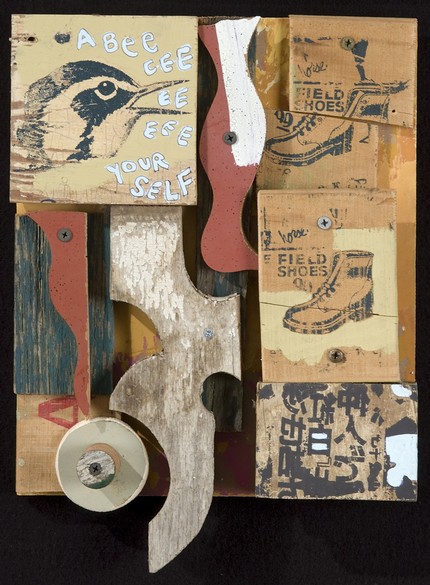Made in Chicago: Dolan Geiman
By Jess D'Amico in Miscellaneous on Nov 23, 2007 9:00PM
 Made in Chicago's taken a short hiatus, but now we're back, full of turkey and thankful for the artists and artisans in our town.
Made in Chicago's taken a short hiatus, but now we're back, full of turkey and thankful for the artists and artisans in our town.
Dolan Geiman grew up in the Shenandoah Valley of Virginia on his family's Christmas tree farm. Dolan started making things from an early age and exploring the Blue Ridge Mountains near his home. His work reminds us of traipsing around old barns and making tree forts back in Tennessee.
Dolan and his business partner Ali Walsh, 30 and 27 respectively, sell Dolan's Southern inspired art from both their Etsy shop, and a brick and mortar store (by appointment only). We adore his recycled and repurposed artwork, like the ABC Yourself painting to the left. Now if anyone wants to help us invest in some piece as a Christmas present . . .
Dolan and Ali talked to us a bit about wearing pink shirts as a kid, broom and dustpan desserts, and why they don't buy into DIY culture:
Chicagoist: How do you make your art stand out on Etsy?
Ali: Our Etsy situation is unique. Since Dolan and I travel across the United States doing fine art and craft fairs, the majority of our Etsy traffic comes from individuals that have seen the work first hand, visit our website, and click through to Etsy to view available works. In recent months, we have paid to advertise in gift guides produced by independent design blogs like Modishoppe, Mixed Plate, Indie Fixx, and Poppytalk to further increase traffic to our Etsy shop.
C: What are the pros and cons of a brick and mortar shop as opposed to online?
Dolan: An online sale through Etsy means a new customer relationship I can sustain and further cultivate. I also maintain 100% control with online sales. However, total control also means more work; managing an online store, even with Etsy, is very time consuming. If I didn’t have a full-time business partner, I would probably rely more on stores to serve as my agent.
C: Where do you want to go in five years?
Dolan: I will be expanding my repertoire of stores and retailers and would love to include places like Anthropologie and Target as well as small boutiques and shops in new cities. I will be returning to some earlier products that were put on the back burner, such as porcelain sushi trays, stemware, and more functional décor like vases and mirrors. Along these same lines, I’d like to collaborate with independent designers and small home wares companies to expand into other product lines such as stationery, dishware, textiles, wall treatments, etc. It’s going to be a busy five years, to say the least.
C: How did you first get into DIY?
Dolan: When I was five, my brother and I dyed shirts with poke berry juice and wore them to school. The only problem was that they faded and turned pink which, at that time, meant you were not cool. Oh well, I still wore them, and with matching pink socks to boot. But mainly my mother encouraged us to live in the DIY spirit. Most of the things I had for toys and games were handmade or homemade, and my mother constantly challenged us to make our own entertainment with what we could find. We made LOTS of mud pies, but also more useful things like homemade soap and yard games in the spirit of horseshoes. I made clothes for friends in high school, and dressed most of my peers in college, at which time I started selling the things I made to pay for art supplies.
C: What does your artistic process look like?
Dolan: My process looks like the rainy Monday after an estate sale, working cleanup at a library fire, and a demolition crew barn party, with a side of ink and acrylic and a broom and dustpan for dessert.
C: What does the Chicago DIY scene look like?
Dolan: The DIY scene of Chicago is split into two groups: on the left, the hipster hobbyists whose financial cushion affords them the ability to be capricious with their pricing (i.e., a handmade pillow that took 10 hours to make for $5). On the right, business-minded designers who are constantly pushing the realm of DIY and are connected to communities beyond the scope of DIY. I think Chicago will always be a great place for independent designers because of the way these two factions intermix and create a looser, more relaxed environment for someone to launch an art/craft/design business.
C: Where do you see DIY culture going?
Dolan: I heard an interesting comment on the radio the other evening. A woman was talking about Bill Clinton/Mayor Daley’s green building initiatives and about how the concept of green design should no longer be thought of as an experiment or a subset, but that it should be the norm. I think the same is true for the notion of DIY.
C: Any interesting offers of barters for your work?
Dolan: Am I willing to barter your artwork for any of the following: a cabin in Canada, pies and cakes, fishing trips, or a Sunday dinner at someone else’s grandma’s house? I would have to say “yes” to all of the above. Seriously, if you have access to a sweet fishing spot, let’s talk.
If you know someone who should be in Made in Chicago, let us know: madeinchicago@chicagoist.com